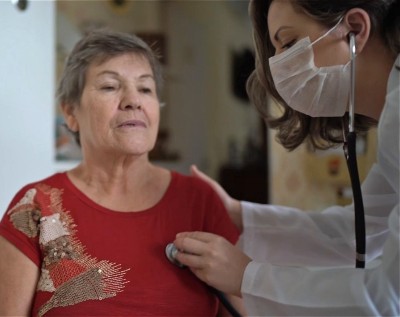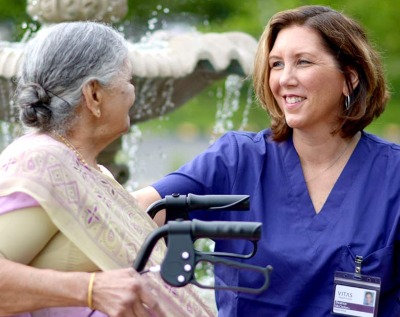Why VITAS Offers an Open Formulary and How It Benefits Patients
By John Pagliano, Vice President, Pharmacy, VITAS Healthcare
Medications can be a lifeline for patients with a serious illness, reducing their pain and providing relief from symptoms. Appropriate drug therapy increases their comfort and enhances their quality of life. Ensuring that end-of-life patients receive necessary medications eases their stress—and the family caregivers’—during a vulnerable time in their lives.
To provide proper drug therapy, clinical hospice experts create a plan of care related to the patient’s advanced disease state. While no longer treating the disease itself, the hospice orders, pays for, and arranges delivery for medication related to the terminal diagnosis as described in the plan of care. The Centers for Medicare & Medicaid Services (CMS) require this provision of medication for palliating the symptoms of terminal illness and related conditions in hospice.
The Value of an Open Formulary
VITAS offers an open formulary for hospice patients. To my knowledge, VITAS is the only hospice provider that offers an open formulary as of this writing.
Why would patients and families prefer an open formulary?
All insurance companies and nearly all hospices use a closed formulary and only pay for certain drugs, which are mostly based on cost. If a medication falls outside their formulary, the provider requires prior authorization and/or step therapy, which means the patient must try alternatives first before the provider approves a nonformulary drug. Most drugs outside the formulary are not approved.
With an open formulary, VITAS pays for any drugs related to the terminal diagnosis and associated conditions that the physician deems necessary. If these medications are the proper therapy and follow the physician’s plan of care, they are automatically approved. They require no further authorization.
The open formulary includes both brand and generic options. If generic is available, it is used first.
Data indicates the probability of patient rehospitalization decreases with access to an open formulary and proper plan of care. If a patient is already in the hospital—yet not on hospice—they can shorten their length of stay through a physician discharge into hospice with an open formulary, following their plan of care.
Why Medication May Change in Hospice
Medications used to treat symptoms of a terminal diagnosis may change as a patient ages and their disease state alters the body. For example, the vast majority of COPD patients can no longer use a handheld inhaler. Their dexterity and ability to coordinate an inhaler are no longer effective. In these cases, VITAS will provide other therapies to treat symptoms, such as nebulizers or oral steroids.
Pharmacology looks at four phases of drug therapy, summarized by the acronym ADME:
- How the body absorbs the medication (absorption)
- How it is distributed through the body (distribution)
- How the body metabolizes the drug components (metabolism)
- How the body eliminates or excretes the drug (elimination)
In hospice, physicians weigh the risk versus the reward of medication as they consider its side effects. For example, when prescribing anticoagulants, clinicians would assess the risk of stroke against that of a brain bleed from a fall. Additionally, some drugs are no longer effective in the late stages of disease and create untoward side effects such as nausea and vomiting.
At multiple points in the care process, clinicians evaluate the drug therapy protocol. When admitted to hospice, VITAS physicians make an initial assessment and create a plan of care for the patient. This plan is constantly evolving. Nurses update plans of care weekly, and the interdisciplinary team discusses the plans biweekly in their team meeting. A caregiver’s alert or patient change of status also triggers an adjustment to the plan of care.
Typical Hospice Drug Therapies
CMS regulations state medication therapy in hospice must palliate a symptom, not treat the disease causing it. This means, for instance, that immunotherapy for cancer is considered a treatment and not palliation because it is not symptom-related and would not be approved.
In some instances, disease-directed treatment may provide palliation of a symptom. Hormonal therapy for prostate cancer may be palliative, so it can be approved.
As directed by CMS, four classes of drugs are approved and paid for by hospice for any reason:
- Pain management
- Anti-anxiety
- Bowel regimen
- Nausea and vomiting
Payment and Delivery: Reducing Stress for Patients and Caregivers
VITAS nurses profile all patient medications and review them during every visit to facilitate refills, complaints, compliance issues, and confirm effectiveness. VITAS provides all prescriptions and medications related to a hospice patient’s terminal diagnosis:
- Regardless of formulary
- In a timely manner
- With no roadblocks
Enclara, our pharmacy partner, is regulated under standard federal and state laws related to pharmacy and audited by their parent company Humana as well as the VITAS pharmacy division. If a nursing home mandates the use of their pharmacy provider, VITAS facilitates access and bills this through our pharmacy benefit manager.
Patients receive most medication either through mail order or delivery by a VITAS courier or team member. Maintenance medications arrive through next-day mail order. Emergency or stat needs typically are funneled through the local network of contracted pharmacies and may be picked up by the family caregiver or patient, if able.
For those who live in areas of diversion risk, safe delivery may involve:
- Required signature for mail order delivery
- Office delivery and team member drop off
For pharmacological needs unrelated to the terminal diagnosis and related conditions, the patient or caregiver obtains and pays for these medications. Drugs not related to the terminal process can be paid for by:
- Medicare Part D
- Medicaid
- Other insurance
- Out of pocket
VITAS clinicians do monitor the use of non-related drugs for their effectiveness and potential to cause a hospitalization or disease/drug interactions. Overall, compliance with the approved and appropriate drug therapy can prevent rehospitalizations.
Polypharmacy and Deprescribing
Polypharmacy, or the use of multiple drugs, causes some or all of the following:
- Delirium
- Cognitive deficits
- Confusion
- Falls
- Dizziness
- Drop in blood pressure
- Reduced appetite
- Constipation
Deprescribing is the hallmark of any proper therapy—and most important in hospice. Clinicians discuss reducing the pill burden with the patient nearing the end of life often to increase their quality of life.
Nonpharmacological Interventions
Too many times we rush to drugs to solve a patient’s discomfort. Nonpharmacological interventions offer all the benefits without the side effects of drugs. Here are a few options:
- Terminal secretions generally don’t bother the patient but may trouble their family or caregiver. Medications used for secretions have side effects and can contribute to confusion and delirium in the late stages of disease. Proper positioning of the patient on their side with their head slightly elevated and a towel beneath the mouth will allow secretions to more readily drain out without pharmacologic intervention. Nurses train family members on how to position the patient into this recovery position.
- A nasal gastric tube can be placed to reduce nausea and vomiting with no side effects.
- Portable fans on the side of the bed are for patients with air hunger or shortness of breath that are not hypoxic. These fans augment medications by producing a wave of air, providing the illusion of better intake and reducing anxiety.
A more comfortable patient is a happier patient. Pharmacological and nonpharmacological interventions in hospice treatment provide palliation of symptoms—and this is what the patient with serious illness desires.

The VITAS Advantage
By choosing VITAS for your hospice and palliative care needs, you, your patients or residents, and their families realize benefits that other providers cannot offer.
Learn More
